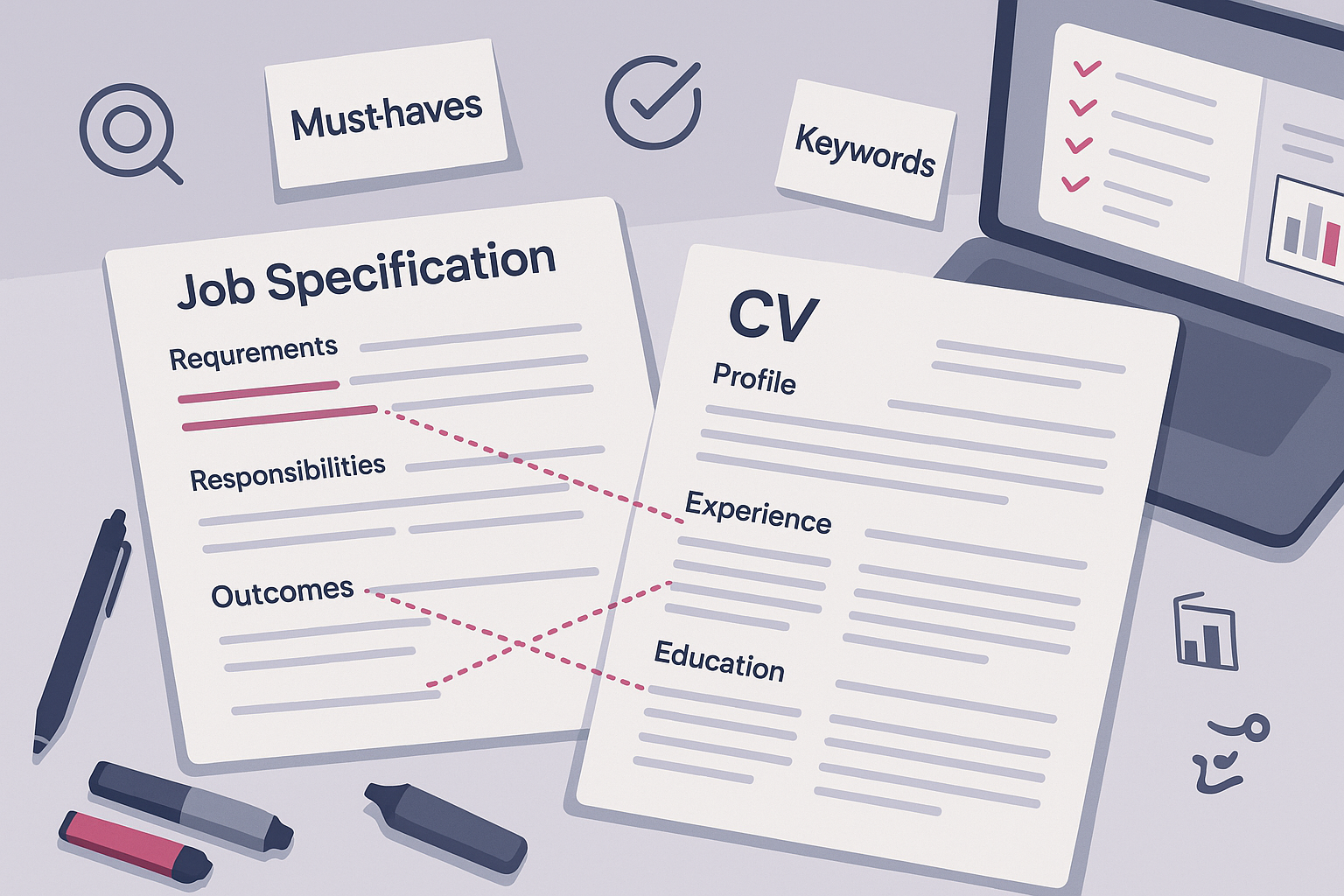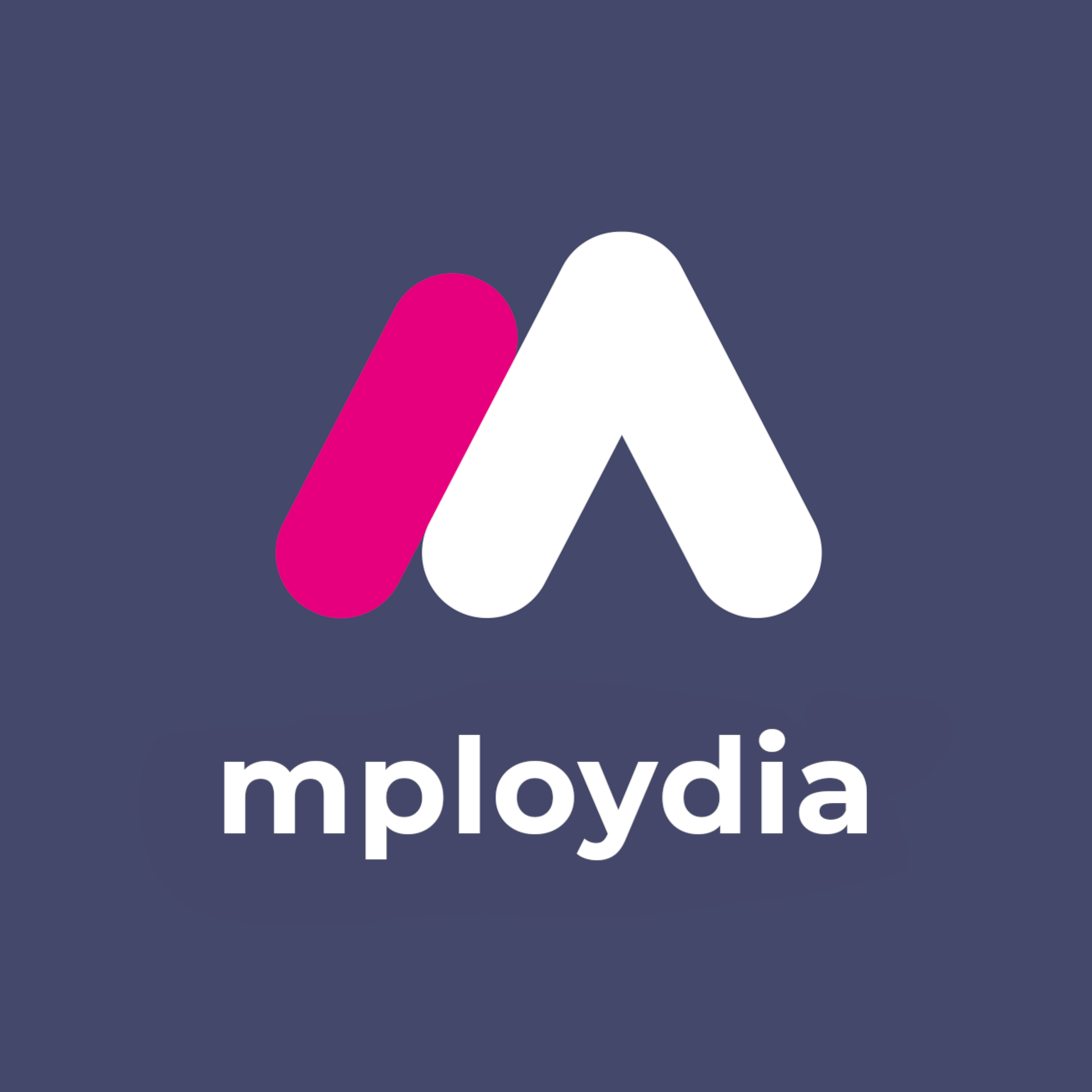
Map Your CV to the Job Spec: A Tactical Step-by-Step Guide
If you’re sending the same CV to every role, you’re wasting time. Hiring managers and ATS filters are not guessing what you mean. They compare your CV to the job spec. If it doesn’t map, it doesn’t move forward. Here’s the no-nonsense, engineer-level process to map your CV to the job spec and get shortlisted consistently.
Why most CVs fail: they don’t map to the spec
Most rejections aren’t about intelligence or potential. They’re about mismatched evidence. Common failures:
- Generic claims with no proof
- Irrelevant details drowning out relevant ones
- Missing must-have keywords the ATS is scoring for
- Duties listed instead of outcomes and impact
- No clear link between what the role needs and what you’ve done
Fix the mapping and you fix your hit rate.
Decode the job spec like an engineer
Stop scanning. Parse it. You’re building a requirements list that your CV must prove.
Extract the signal: must-haves, outcomes, constraints
- Must-haves: Required skills, tools, certifications, experience levels, working rights
- Outcomes: What success looks like after 3 to 12 months. Words like improve, reduce, deliver, increase
- Constraints: Industry, customers, size, compliance, hours, shifts, travel, on-site vs hybrid
- Repeated verbs and nouns: These are scoring terms. Mirror the exact phrasing
- Culture and behaviours: Ownership, attention to detail, customer focus, teamwork, adaptability
- Metrics mentioned: SLAs, CSAT, NPS, conversion rate, on-time delivery, accuracy
Build a requirements stack
- Tier 1: Non-negotiables. If you cannot show these, create equivalent evidence or move on
- Tier 2: Highly weighted desirables. Add them, don’t bury them
- Tier 3: Nice-to-haves. Include if space allows and if they reinforce your fit
Your CV should demonstrate Tier 1 clearly in the top third of page one and cover Tier 2 throughout experience bullets.
Construct a role-to-CV mapping grid
Don’t guess. Map each requirement to a proof point on your CV. Use this simple text template:
Requirement-to-Evidence Map
- Requirement: [Exact phrase from job spec]
- Your Evidence: [Specific bullet, project, or result]
- Proof Type: [Metric, project, tool, certification, stakeholder]
- Placement: [Profile, Skills, Role X bullet 2]
- Keywords to Use: [Exact phrases from the spec]
Example for an entry-level Operations Assistant role:
- Requirement: Maintain accurate records and update spreadsheets daily
- Your Evidence: Processed 120+ records daily with 99.5 percent accuracy across two spreadsheets using Excel
- Proof Type: Metric, tool
- Placement: Experience, Role A, bullet 1; Skills section
- Keywords to Use: accurate records, spreadsheets, Excel
- Requirement: Communicate with customers via email and phone with professionalism
- Your Evidence: Resolved 25 to 30 customer queries weekly via email and phone, achieving 4.7 out of 5 CSAT
- Proof Type: Metric, stakeholder
- Placement: Experience, Role B, bullet 2
- Keywords to Use: communicate, email, phone, professionalism, customer
- Requirement: Work collaboratively with cross-functional teams
- Your Evidence: Coordinated with sales and logistics to fulfil 60+ weekly orders, reducing errors by 18 percent
- Proof Type: Cross-functional, metric
- Placement: Experience, Role A, bullet 3
- Keywords to Use: cross-functional, collaborate, logistics, sales
Build this grid for every application. It forces discipline.
Rewrite your CV around the mapping
Your CV structure should be clean and ATS-safe: Profile, Core Skills, Experience, Education, Certifications, Projects. No graphics, text boxes, icons, or multiple columns that break parsing.
Profile: prove fit in three lines
- Line 1: Job title you’re targeting + top must-have + core outcome
- Line 2: 2 to 3 tools or domains from the spec + a metric
- Line 3: Behavioural strength tied to outcome
Example: Graduate Data Analyst with strong Excel and SQL, focused on accurate, timely insight delivery. Built dashboards used by two departments, reducing weekly reporting time by 30 percent. Recognised for attention to detail and clear communication with non-technical stakeholders.
Core Skills: mirror the spec without stuffing
- Use the exact phrasing from the job spec where accurate for you
- Group by category: Tools, Methods, Domains, Soft Skills
- Keep to 10 to 14 items, prioritising Tier 1 and Tier 2
- Avoid vague items like good communication skills. Use the employer’s language: stakeholder communication, customer email handling, CRM data hygiene
Experience: write impact bullets, not duties
Use a consistent formula: Action verb + tool or context + scope + metric + outcome + stakeholder.
- Improved order accuracy by 18 percent by auditing 500+ weekly entries in Excel, enabling on-time delivery for 40 B2B customers
- Resolved 30+ weekly customer tickets via email and phone, achieving 4.7 out of 5 CSAT and meeting 24-hour SLA
- Created a KPI dashboard in Google Sheets used by sales and operations, cutting weekly reporting time from 6 hours to 3
- Coordinated rota for 12 volunteers, increasing coverage by 25 percent and reducing missed shifts to zero
If you lack formal experience, use projects, volunteering, coursework, internships, hackathons, part-time work, or society roles. Evidence still matters.
Projects: targeted proof for Tier 1
Add 1 to 3 short projects aligned to the spec, especially for early-career candidates.
- Inventory tracking spreadsheet with conditional formatting. Accuracy improved from 92 percent to 99.2 percent across 300 items
- Social media content calendar and report. Weekly reach increased by 240 percent and engagement by 3.1 times in 8 weeks
- Survey analysis using Excel pivot tables. Identified top 3 issues causing 65 percent of complaints, informing process fixes
Quantify everything: numbers beat adjectives
Replace claims with metrics. If you don’t have exact numbers, estimate responsibly using ranges or percentages.
- Volume: customers served, orders processed, records handled, hours saved
- Speed: turnaround time, SLA adherence, deadlines met
- Quality: accuracy rate, error reduction, satisfaction scores, compliance
- Impact: revenue influenced, cost avoided, waste reduced, adoption rate
Quick metric ideas for first-time jobseekers:
- Student society: grew membership by X percent, raised £Y, delivered Z events on time
- Retail/hospitality: average items per hour, upsells, till accuracy, mystery shop score
- Volunteering: people supported, sessions delivered, funds raised, process improved
- Coursework: team size, dataset size, project duration, grade, stakeholder
Make it ATS-safe without sounding robotic
ATS is simple: parse, score, rank. Don’t fight it. Feed it correctly.
- File type: .docx or .pdf from Word. Name files like Firstname_Lastname_CV_JobTitle.docx
- Headings: Profile, Skills, Experience, Education, Certifications, Projects
- Job titles: Use standard titles. If your title was unusual, write the standard title then actual title in brackets
- Keywords: Use exact phrases from the job spec, once in Skills and 1 to 2 times in Experience where true
- Layout: Single column, no tables or text boxes, normal margins
- Dates: Use consistent format, e.g., Mar 2023 to Present
- Avoid logos, headers/footers with vital info, and images
Tailor by job family: four mapping playbooks
Customer Service Representative
- Must-haves: Email and phone handling, empathy, SLA discipline, CRM familiarity
- Keywords: CSAT, first contact resolution, ticket triage, Zendesk/Freshdesk/CRM
- Evidence ideas: Response times, CSAT, resolution rate, queue handling volume
Marketing Assistant
- Must-haves: Content scheduling, basic analytics, copywriting, stakeholder coordination
- Keywords: social content calendar, engagement, CTR, UTM tracking, Canva
- Evidence ideas: Posts per week, engagement lift, campaign support, asset delivery on time
Data Analyst (Graduate)
- Must-haves: Excel, SQL basics or willingness to learn, data cleaning, reporting
- Keywords: pivot tables, VLOOKUP/XLOOKUP, dashboards, data quality
- Evidence ideas: datasets cleaned, time saved, error reduction, stakeholders using reports
Operations Coordinator
- Must-haves: Scheduling, spreadsheet maintenance, process improvement, communication
- Keywords: on-time delivery, stock accuracy, SOP, cross-functional
- Evidence ideas: order accuracy, stock variance reduction, SLA adherence, coordination volume
When you lack a requirement: bridge, don’t bluff
- Substitute equivalent tools or methods and show results. No SQL? Show advanced Excel joins with XLOOKUP, Power Query, or pivot tables
- Upskill fast. 10 to 15 hours on a targeted course, then build a micro-project. Add both to Projects and Skills
- Show proximity. Even if you haven’t done X, show you’ve done adjacent Y that proves the same behaviour or thinking
- Be transparent. Avoid false claims. Employers test skills quickly
Example bridge: Job asks for Salesforce. You used HubSpot. Write: Maintained CRM data hygiene and pipeline updates in HubSpot; familiar with Salesforce concepts and completed hands-on trail for Leads and Opportunities
Quality control: 15-minute pre-submission checklist
- Job title mirrored in Profile and in the file name
- Core Skills match Tier 1 and Tier 2 from the spec, using exact phrases
- Each Experience bullet maps to at least one requirement and contains a metric
- Irrelevant content removed or pushed down
- ATS-safe headings and single-column layout
- Spelling and UK English throughout
- Contact details correct, professional email, LinkedIn link added
- Dates and job titles consistent and standardised
- No unexplained gaps. If needed, add a single line for relevant self-study or volunteering
- One-page for entry-level is fine. Two pages acceptable if every line earns space
Common mistakes that cost interviews
- Keyword dumping without proof
- Dense blocks of text with no scannable bullets
- Duties listed without outcomes
- Hiding the best evidence on page two
- Fancy formatting the ATS can’t read
- Vague soft skills with no behavioural proof
- Ignoring the spec and sending a generic CV
Fast workflow: 30-minute CV mapping sprint
- Minute 0 to 5: Highlight must-haves, outcomes, and repeated terms in the job spec
- Minute 5 to 10: Build a quick Requirement-to-Evidence Map for Tier 1 and Tier 2
- Minute 10 to 15: Rewrite Profile and Core Skills to mirror the spec
- Minute 15 to 25: Edit Experience bullets to add metrics and match keywords
- Minute 25 to 28: Trim irrelevant content. Push non-matching items down or out
- Minute 28 to 30: Run the checklist. Save and name the file properly. Submit
This beats paralysis and gets you to a strong tailored CV fast.
Example: turn a generic bullet into mapped bullets
Role: Retail Assistant. Target role: Customer Service Representative.
Generic bullet
- Helped customers and managed till
Mapped bullets
- Resolved 40 to 60 customer queries daily at the till and on the shop floor, maintaining a 98 percent till accuracy rate
- Prioritised peak-time queues to meet a 3-minute average wait time, contributing to consistent positive feedback
- Documented returns and exchanges accurately in the POS system, reducing processing errors by 22 percent
Why it works: It mirrors customer service outcomes, includes metrics, and shows discipline under pressure. It aligns with the job spec without exaggeration.
Write impact statements using STAR tightly
- Situation/Task: Minimal or implied. One phrase at most
- Action: Strong verb + tool or method
- Result: Quantified, with a stakeholder or business outcome
Examples
- Consolidated 4 spreadsheets into a single tracker using VLOOKUP, cutting weekly reconciliation time from 3 hours to 45 minutes
- Prioritised and closed 25+ support tickets per week via email, maintaining a 24-hour SLA and 4.6 out of 5 CSAT
- Coordinated 6-event student programme with a team of 8, delivering on time and under budget by £300
Cover letter: map the narrative, not the whole CV
Your cover letter should connect 3 to 4 must-haves to clear proofs. Keep it direct.
- Opening: State role and fit in one sentence
- Middle: Three short paragraphs, each pairing a requirement with a quantified proof
- Closing: Availability, enthusiasm, and a call to speak
Do not repeat your CV. Do not write more than one page.
Handling vague, bloated, or confusing job specs
- Extract the core: What outputs do they want weekly or monthly
- Find comparables: Search similar job titles to triangulate key skills and tools
- Use their website and LinkedIn posts to spot work in progress, systems in use, and language patterns
- If in doubt, ask a precise question via email or LinkedIn. Keep it professional and short
Portfolio and links for early-career candidates
- GitHub or Google Drive folder for relevant projects, with short READMEs stating problem, approach, and result
- Public dashboards or reports (with dummy data if needed)
- Writing samples for content roles, or a single-page case study for operations improvements
- Link in Profile. Ensure link privacy settings allow access
Version control: keep a master, never start from zero
- Master CV: Everything you can credibly claim, with metrics
- Role-specific copies: Remove, reorder, and rewrite based on the mapping grid
- Track which phrases triggered interviews. Reuse winners
Proofread like a hiring manager
- Read aloud. You’ll catch awkward phrasing
- Print to PDF and skim. Check scanning order and headings
- Ask someone to match three requirements to three bullets in 60 seconds. If they can’t, your mapping is weak
Your 7-minute diagnostic after a rejection
- Re-open the job spec. Highlight must-haves you missed or buried
- Compare your Profile and Skills with the top 5 requirements
- Rewrite two weakest bullets with metrics
- Add one small project to cover a missing tool and resubmit to a similar role
Mini mapping recipes by keyword
- Excel: include pivot tables, XLOOKUP, conditional formatting, data cleaning, with a time or accuracy metric
- Customer service: include CSAT, SLA, first contact resolution, volume handled, and channel mix
- Coordination: include schedules managed, dependencies, cross-team coordination, on-time delivery rate
- Analysis: include problem definition, methods used, insights produced, decision influenced
Final pass: a one-look alignment test
Hold your CV next to the job spec. Can a stranger draw lines from their top bullets to your top lines without asking you anything? If not, your mapping is incomplete.
Bottom line
You don’t get interviews for being generally capable. You get interviews for being specifically relevant. Map your CV to the job spec with discipline. Mirror their language, prove with numbers, and put the right evidence where they can’t miss it. Do the work. Get the call.
Next Steps
Want to learn more? Check out these articles:
First Job CV Proof Points Employers Notice, Trust and Act On
Write Impact Statements Not Duties on Your CV to Get Hired
Show You’re Job-Ready With No Experience: 10 Proven Tactics
Check out our Advanced Employability Course for all the help you need to get your dream job, fast.


